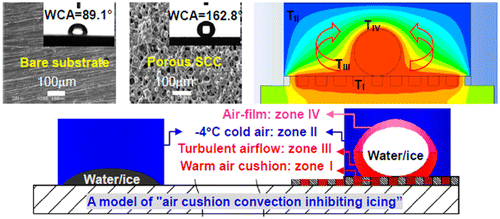Abstract: Anti-icing surfaces/interfaces are of considerable importance in various engineering fields under natural freezing environment. Although superhydrophobic self-cleaning surfaces show good anti-icing potentials, promotion of these surfaces in engineering applications seems to enter a "bottleneck" stage. One of the key issues is the intrinsic relationship between superhydrophobicity and icephobicity is unclear, and the dynamic action mechanism of "air cushion" (a key internal factor for superhydrophobicity) on icing suppression was largely ignored. Here we report that icing inhibition (i.e., icing-delay) of self-cleaning surfaces is mainly ascribed to air cushion and its convection. We experimentally found air cushion on the porous self-cleaning coating under vacuum environments and on the water/ice-coating interface at low temperatures. The icing-delay performances of porous self-cleaning surfaces compared with bare substrate, up to 10-40 min under 0 to similar to-4 degrees C environments close to freezing rain, have been accurately real-time recorded by a novel synergy method including high-speed photography and strain sensing voltage. Based on the experimental results, we innovatively propose a physical model of "air cushion convection inhibiting icing", which envisages both the static action of trapped air pocket without air flow and dynamic action of air cushion convection. Gibbs free energy of water droplets increased with the entropy of air derived from heat and mass transfer between warmer air underneath water droplets and colder surrounding air, resulting in remarkable ice nucleation delay. Only when air cushion convection disappears can ice nucleation be triggered on suitable Gibbs free energy conditions. The fundamental understanding of air cushion on anti-icing is an important step toward designing optimal anti-icing surfaces for practical engineering application. KeyWords Plus:SUPERHYDROPHOBIC SURFACES; WATER-REPELLENT; ICE NUCLEATION; POROUS SURFACES; ICEPHOBICITY; FABRICATION; RESISTANCE; LUBRICANT; SLIPPERY; DESIGN Published in ACS APPLIED MATERIALS & INTERFACES, 8 (42):29169-29178; 10.1021/acsami.6b10165 OCT 26 2016
|
